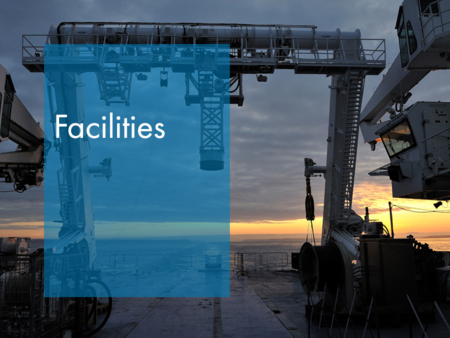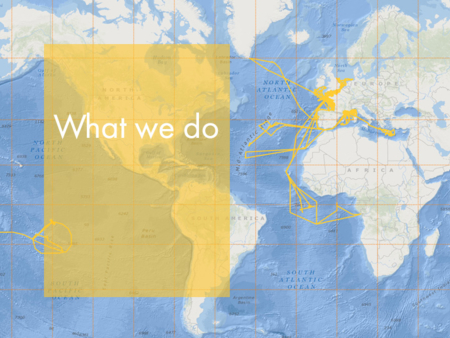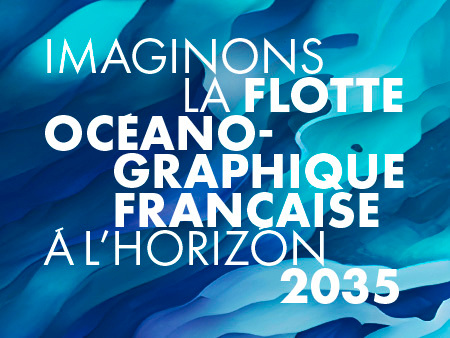A beam trawl is used for collecting megafauna, that is to say large benthic fauna (invertebrates and fish bigger than 2 cm). Samples give information on the structure and size of the fauna, and provide the basis for estimations of density and biomass.
A beam trawl comprises a fixed beam which has a metal skid at each end. This rigid structure keeps the mouth of the trawl-net open. Chains are fixed to the underside of the net.
The chains scrape the sea floor and force the benthic fauna into the trawl-net. The aim is to harvest as many animals as possible while collecting the least amount of sediment and rock.
Two trawl nets are available, one with a 6 m beam, the other with a 4.4 m beam.
The French Oceanographic Fleet has at its disposal bottom, pelagic, mesopelagic, and micronekton trawl nets.
Bottom Trawl Net and Rig
The net is towed by the vessel for 2–4 hours before being raised and hoisted on to the deck.
The bottom trawl is towed by the vessel for 30–60 min, perhaps longer depending on the protocol, before being raised and hoisted on to the deck.
The bottom trawl comprises a conical net which is attached to the vessel by steel cables, known as warps. Divergent panels known as “otter boards” keep the mouth of the net open on the horizontal plane. The trawl net is attached to the otter boards by cables known as “legs”.
A rope fitted with floats, known as the “headline”, is attached to the upper edge of the net to keep it open on the vertical plane. A “ground rope” fitted to the leading edge of the “belly” (underside) keeps the trawl net in contact with the sea floor. The ground rope is weighted and takes various forms depending on the nature of the sea floor. Trawling speed is 2–4 knots depending on the targeted species and the ship’s capabilities.
The mesh size of the holding part of the trawl, known as the “cod end”, is regulated by law and depends on the species targeted. The meshes of the main body of the trawl are generally larger to reduce the resistance of the net through the water as they only serve to guide the animals towards the cod end.
Pelagic Trawl Net and Rig
The pelagic or midwater trawl net does not touch the sea floor.
Similar to the bottom trawl, pelagic trawls are either towed by a single vessel or in pairs. The mouth of a pelagic trawl net is generally much larger than that of a bottom trawl. Its forward part comprises ropes or very large meshes which guide the fish towards the cod end of the net.
The depth of the trawl is controlled by a sounder fitted to the forward end of the net, called a “netsounder”.
Mesopelagic Trawl
The mesopelagic trawl is a small midwater net towed on a single warp and thus requires only one winch. Its mouth is kept open by kites or parachutes. The net is approximately 40 m in length and has an elliptical opening of approximately 50 m². Mesh size at the mouth is 30 mm and gradually reduces to between 10 mm and 4 mm at the cod end. The horizontal and vertical dimensions of the mouth and the depth of the headline are monitored in real time using Scanmar sensors. Trawling speed is 2–4 knots.
This trawl is easier to handle than the micronekton trawl, but it harvests smaller organisms because of its smaller mouth and denser mesh.
It is used to determine the composition of zooplankton and micronekton layers detected, in particular, during acoustic surveys.
It can harvest samples of micronektonic fauna (fish, molluscs, crustaceans, jellyfish of 1–30 cm long) and large mesozooplankton from the surface down to a depth of 600 m in open water (depending on the power of the vessel and the length of the warp).
The dispersed layers are difficult to harvest with a plankton net or a standard pelagic trawl because of the size of the organisms and the depth at which they live.
The mesopelagic trawl solves this problem thanks to its light rig (which enables it to make runs easily at the desired depth) and the small mesh at the cod end, which ensures the satisfactory capture of these species.
Micronekton Trawl (Alis and Antea)
The micronekton trawl is a pelagic trawl net. Its mouth is held open by two large metal boards and it requires two warps and, therefore, two winches. The net is approximately 55 m in length and has a headline and a belly line which are 24 m long. It has a square opening of approximately 100 m². Mesh size at the mouth is 80 mm and gradually reduces to 10 mm at the cod end. The horizontal and vertical dimensions of the mouth and the depth of the headline are monitored in real time using Scanmar sensors.
Trawling speed is 2–4 knots.
This trawl can harvest samples of micronektonic fauna (fish, molluscs, crustaceans, jellyfish of 1–30 cm long) from the surface down to a depth of 600 m in open water (depending on the power of the vessel and the length of the warps).




